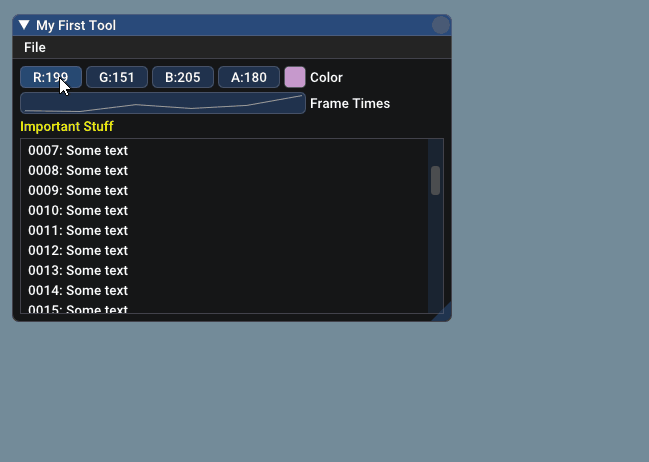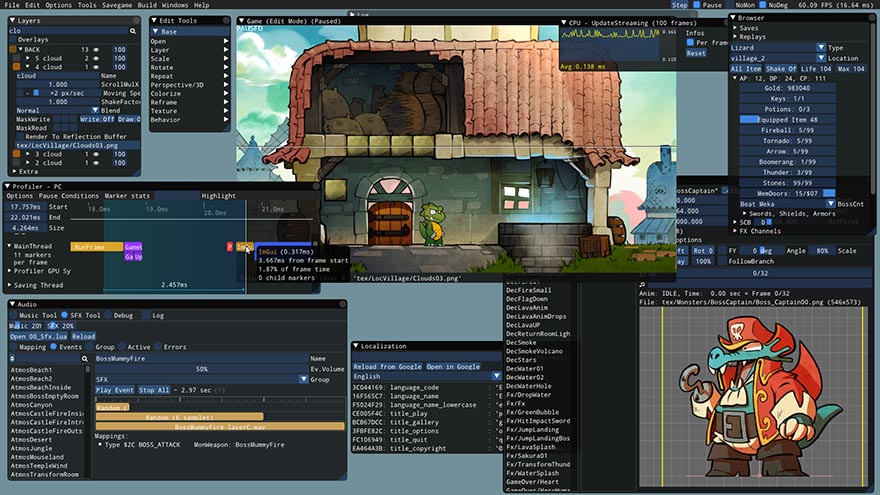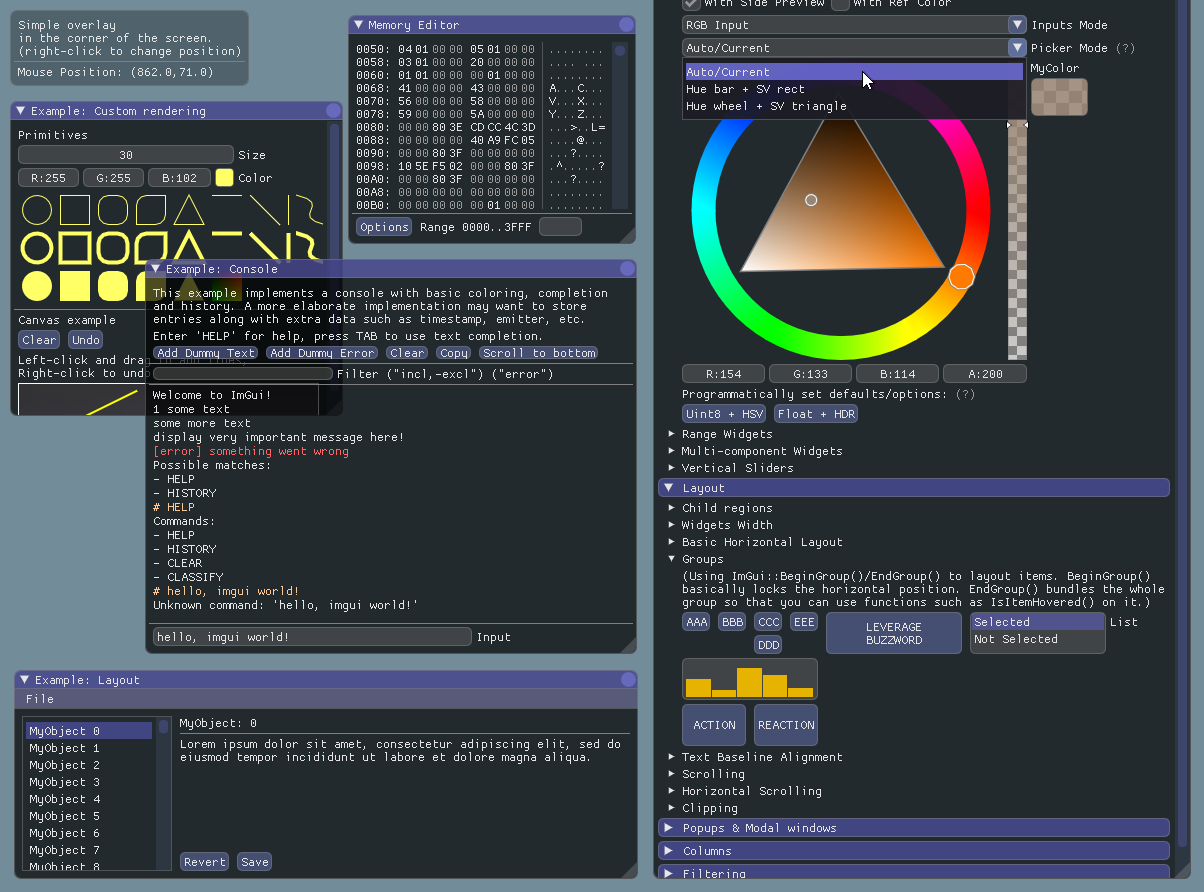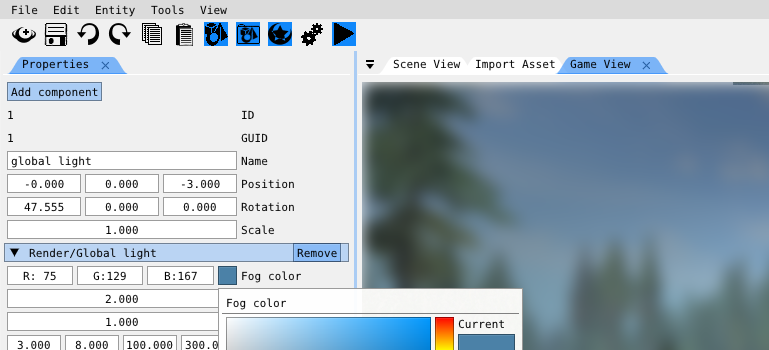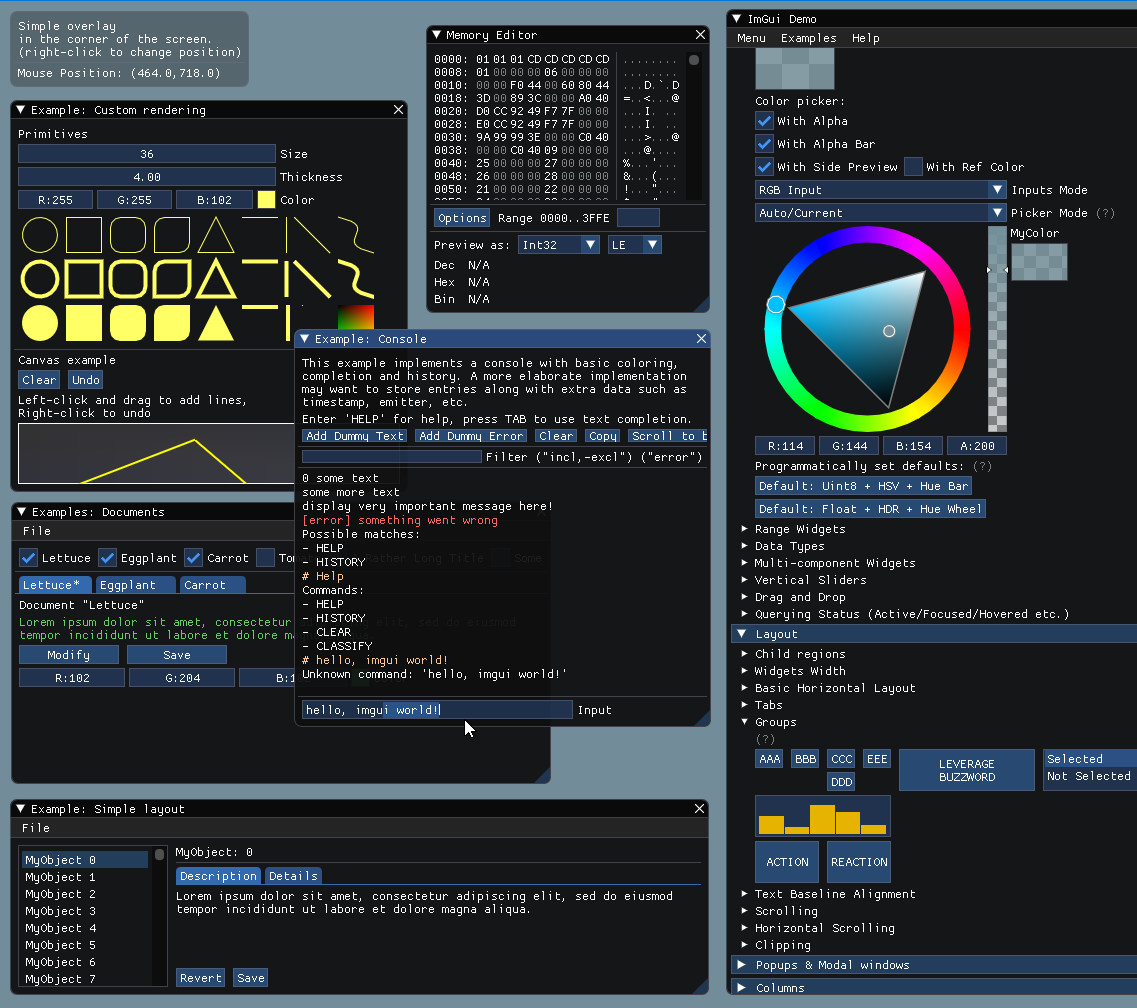Как подключить imgui к проекту
Как установить ImGui
Как подключить библиотеку imgui.net?
Всем привет, наткнулся на днях на библиотеку imgui, решил добавить для С# imgui.net, но каким.
не соображаю как сделать ImGui меню
Main.cpp #include #include «GameClasses.h» BOOL bSpeed, bJump, bDistance, bNoFog.
Подключение ImGui
Всем привет. Можете скинуть код подключения ImGui Hook d3d9 или видео урок?
Решение
Я на sfml imgui ставил используя cmake и vcpkg, заработало без проблем
Путь до vcpkg-master\installed\x64-windows-static-md вставить в строчку set(CMAKE_PREFIX_PATH
А так похоже у вас в исходниках отсутствуют imgui_tables.cpp imgui_widgets.cpp
Они присутствуют. Их тоже надо подключить?
Добавлено через 4 минуты
alecss131, подключил imgui_tables.cpp imgui_widgets.cpp и пример заработал. Все, пошел дальше разбираться. Спасибо!

Приветствую всех. Пишу небольшой 2d движок на чистом c++ с использованием библиотек SFML + ImGui.
ImGUI русские буквы
У меня есть менюшка написана на ImGUi Английский язык воспринимает нормально но вместо русского.
Активация функционального меню по кнопке. ImGui
Нужен Guide по ImGui или что там ещё. Как сделать функциональное меню, которое будет открываться.
DirectX11 c++ imgui неразрешенный внешний символ
https://github.com/ocornut/imgui/blob/master/examples/example_win32_directx11/main.cpp Взял оттуда.

Читаю книгу по Node.js, но понимаю там ооочень много воды, которая мне не нужна и это только.
Использование ImGui с SFML для создания инструментов для разработки игр
Данная статья — вольный перевод моей статьи на русский с некоторыми небольшими изменениями и улучшениями. Хотелось бы показать как просто и полезно использовать ImGui с SFML. Приступим.
Введение
Вот какие инструменты я создал с помощью ImGui для своей игры:

Редактор уровней

Консоль Lua

Редактор анимаций
Как можно видеть, в ImGui есть достаточно разных виджетов, чтобы создавать полезные и удобные интерфейсы.
ImGui и концепция immediate GUI
Immediate mode GUI немного отличается от классической методики программирования интерфейсов, которая называется retained mode GUI. ImGui виджеты создаются и рисуются в каждом кадре игрового цикла. Сами виджеты не хранят внутри себя своё состояние, либо хранят абсолютно минимальный необходимый минимум, который обычно скрыт от программиста.
Данный код должен вызываться в каждой итерации игрового цикла, в которой эта кнопка должна быть доступна пользователю.
Изначально данный концепт может показаться странным и очень неэффективным, однако это всё работает так быстро в сравнении с остальным кодом, что в результате даже сложные интерфейсы не привносят сильных изменений в производительность игры.
Советую посмотреть вот это видео Кейси Муратори про ImGui, если вы хотите узнать чуть больше о данной методике.
Итак, каковы же достоинства ImGui?
Настройка
Добавьте следующие файлы в билд вашего проекта:
Вот небольшой пример кода, который создаёт окошко ImGui и позволяет менять цвет заднего фона и заголовок окна. Объяснения того, что происходит, будут далее.
Вы должны увидеть что-то вроде этого:
Попробуйте изменить что-нибудь. Если кликнуть два раза на одно из полей RGB, то можно ввести соответствующее значение. Если одно из полей потянуть, то можно плавно изменять текущее введённое значение. Поле ввода позволяет изменить заголовок окна после нажатия на кнопку.
Отлично, теперь разберёмся как всё работает.
В игровом цикле ImGui имеет две фазы: обновление и рендеринг.
Если вы рендерите реже, чем обновляете ввод и игру, то в конце каждой итерации вашего update необходимо также вызывать ImGui::EndFrame :
Полезные перегрузки функций для SFML
Заключение
Вот такая библиотека: проста в использовании и настройке, и очень полезна для создания инструментов и дебагинга. Приятного использования!
dear imgui,¶
(This library is free but needs your support to sustain its development. There are many desirable features and maintenance ahead. If you are an individual using dear imgui, please consider donating via Patreon or PayPal. If your company is using dear imgui, please consider financial support (e.g. sponsoring a few weeks/months of development. I can invoice for technical support, custom development etc. E-mail: omarcornut at gmail).
Dear ImGui is a bloat-free graphical user interface library for C++. It outputs optimized vertex buffers that you can render anytime in your 3D-pipeline enabled application. It is fast, portable, renderer agnostic and self-contained (no external dependencies).
Dear ImGui is designed to enable fast iterations and to empower programmers to create content creation tools and visualization / debug tools (as opposed to UI for the average end-user). It favors simplicity and productivity toward this goal, and lacks certain features normally found in more high-level libraries.
Dear ImGui is particularly suited to integration in games engine (for tooling), real-time 3D applications, fullscreen applications, embedded applications, or any applications on consoles platforms where operating system features are non-standard.
Dear ImGui is self-contained within a few files that you can easily copy and compile into your application/engine:
Usage¶
Your code passes mouse/keyboard/gamepad inputs and settings to Dear ImGui (see example applications for more details). After Dear ImGui is setup, you can use it from _anywhere_ in your program loop:
How it works¶
Check out the References section if you want to understand the core principles behind the IMGUI paradigm. An IMGUI tries to minimize state duplication, state synchronization and state storage from the user’s point of view. It is less error prone (less code and less bugs) than traditional retained-mode interfaces, and lends itself to create dynamic user interfaces.
Dear ImGui outputs vertex buffers and command lists that you can easily render in your application. The number of draw calls and state changes is typically very small. Because it doesn’t know or touch graphics state directly, you can call ImGui commands anywhere in your code (e.g. in the middle of a running algorithm, or in the middle of your own rendering process). Refer to the sample applications in the examples/ folder for instructions on how to integrate dear imgui with your existing codebase.
A common misunderstanding is to mistake immediate mode gui for immediate mode rendering, which usually implies hammering your driver/GPU with a bunch of inefficient draw calls and state changes as the gui functions are called. This is NOT what Dear ImGui does. Dear ImGui outputs vertex buffers and a small list of draw calls batches. It never touches your GPU directly. The draw call batches are decently optimal and you can render them later, in your app or even remotely.
Dear ImGui allows you create elaborate tools as well as very short-lived ones. On the extreme side of short-liveness: using the Edit&Continue (hot code reload) feature of modern compilers you can add a few widgets to tweaks variables while your application is running, and remove the code a minute later! Dear ImGui is not just for tweaking values. You can use it to trace a running algorithm by just emitting text commands. You can use it along with your own reflection data to browse your dataset live. You can use it to expose the internals of a subsystem in your engine, to create a logger, an inspection tool, a profiler, a debugger, an entire game making editor/framework, etc.
Demo Binaries¶
You should be able to build the examples from sources (tested on Windows/Mac/Linux). If you don’t, let me know! If you want to have a quick look at some Dear ImGui features, you can download Windows binaries of the demo app here:
Bindings¶
Integrating Dear ImGui within your custom engine is a matter of 1) wiring mouse/keyboard/gamepad inputs 2) uploading one texture to your GPU/render engine 3) providing a render function that can bind textures and render textured triangles. The examples/ folder is populated with applications doing just that. If you are an experienced programmer and at ease with those concepts, it should take you less than an hour to integrate Dear ImGui in your custom engine, but make sure to spend time reading the FAQ, the comments and other documentation!
NB: those third-party bindings may be more or less maintained, more or less close to the original API (as people who create language bindings sometimes haven’t used the C++ API themselves.. for the good reason that they aren’t C++ users). Dear ImGui was designed with C++ in mind and some of the subtleties may be lost in translation with other languages. If your language supports it, I would suggest replicating the function overloading and default parameters used in the original, else the API may be harder to use. In doubt, please check the original C++ version first!
Languages: (third-party bindings)
For other bindings: see Bindings. Also see Wiki for more links and ideas.
Roadmap¶
Some of the goals for 2018 are:
Gallery¶
and input. Here using Arial Unicode font to display Japanese. Initialize custom font with: | Code:
References¶
The Immediate Mode GUI paradigm may at first appear unusual to some users. This is mainly because “Retained Mode” GUIs have been so widespread and predominant. The following links can give you a better understanding about how Immediate Mode GUIs works.
See the Wiki and Bindings for third-party bindings to different languages and frameworks.
Frequently Asked Question (FAQ)¶
Where is the documentation?¶
Which version should I get?¶
I occasionally tag Releases but it is generally safe and recommended to sync to master/latest. The library is fairly stable and regressions tend to be fixed fast when reported.
Who uses Dear ImGui?¶
See the Software using dear imgui page for an (incomplete) list of games/software which are publicly known to use dear imgui. Please add yours if you can!
Why the odd dual naming, “dear imgui” vs “ImGui”?¶
The library started its life and is best known as “ImGui” only due to the fact that I didn’t give it a proper name when I released it. However, the term IMGUI (immediate-mode graphical user interface) was coined before and is being used in variety of other situations. It seemed confusing and unfair to hog the name. To reduce the ambiguity without affecting existing codebases, I have decided on an alternate, longer name “dear imgui” that people can use to refer to this specific library in ambiguous situations.
Various Questions¶
See the FAQ in imgui.cpp for answers.
How do you use Dear ImGui on a platform that may not have a mouse or keyboard?¶
You can control Dear ImGui with a gamepad, see the explanation in imgui.cpp about how to use the navigation feature (short version: map your gamepad inputs into the io.NavInputs[] array and set io.ConfigFlags |= ImGuiConfigFlags_NavEnableGamepad ).
You can share your computer mouse seamlessly with your console/tablet/phone using Synergy. This is the preferred solution for developer productivity. In particular, their micro-synergy-client repo there is uSynergy.c sources for a small embeddable that you can use on any platform to connect to your host PC using Synergy 1.x. You may also use a third party solution such as Remote ImGui.
For touch inputs, you can increase the hit box of widgets (via the style.TouchPadding setting) to accommodate a little for the lack of precision of touch inputs, but it is recommended you use a mouse or gamepad to allow optimizing for screen real-estate and precision.
Can you create elaborate/serious tools with Dear ImGui?¶
Yes. People have written game editors, data browsers, debuggers, profilers and all sort of non-trivial tools with the library. In my experience the simplicity of the API is very empowering. Your UI runs close to your live data. Make the tools always-on and everybody in the team will be inclined to create new tools (as opposed to more “offline” UI toolkits where only a fraction of your team effectively creates tools). The list of sponsors below is also an indicator that serious game teams have been using the library.
Dear ImGui is very programmer centric and the immediate-mode GUI paradigm might requires you to readjust some habits before you can realize its full potential. Dear ImGui is about making things that are simple, efficient and powerful.
Can you reskin the look of Dear ImGui?¶
You can alter the look of the interface to some degree: changing colors, sizes, padding, rounding, fonts. However, as Dear ImGui is designed and optimized to create debug tools, the amount of skinning you can apply is limited. There is only so much you can stray away from the default look and feel of the interface. Below is a screenshot from LumixEngine with custom colors + a docking/tabs extension (both of which you can find in the Issues section and will eventually be merged):
Why using C++ (as opposed to C)?¶
Dear ImGui takes advantage of a few C++ languages features for convenience but nothing anywhere Boost-insanity/quagmire. Dear ImGui does NOT require C++11 so it can be used with most old C++ compilers. Dear ImGui doesn’t use any C++ header file. Language-wise, function overloading and default parameters are used to make the API easier to use and code more terse. Doing so I believe the API is sitting on a sweet spot and giving up on those features would make the API more cumbersome. Other features such as namespace, constructors and templates (in the case of the ImVector<> class) are also relied on as a convenience.
There is an reasonably maintained c-api for ImGui by Stephan Dilly designed for binding in other languages. I would suggest using your target language functionalities to try replicating the function overloading and default parameters used in C++ else the API may be harder to use. Also see Bindings for third-party bindings to other languages.
Support dear imgui¶
How can I help financing further development of Dear ImGui?
Your contributions are keeping the library alive. If you are an individual using dear imgui, please consider donating to enable me to spend more time improving the library.
If your company uses dear imgui, please consider financial support (e.g. sponsoring a few weeks/months of development. I can invoice for private support, custom development etc. E-mail: omarcornut at gmail). Thanks!
Credits¶
Developed by Omar Cornut and every direct or indirect contributors to the GitHub. The early version of this library was developed with the support of Media Molecule and first used internally on the game Tearaway.
I first discovered imgui principles at Q-Games where Atman had dropped his own simple imgui implementation in the codebase, which I spent quite some time improving and thinking about. It turned out that Atman was exposed to the concept directly by working with Casey. When I moved to Media Molecule I rewrote a new library trying to overcome the flaws and limitations of the first one I’ve worked with. It became this library and since then I have spent an unreasonable amount of time iterating on it.
Embeds ProggyClean.ttf font by Tristan Grimmer (MIT license).
Inspiration, feedback, and testing for early versions: Casey Muratori, Atman Binstock, Mikko Mononen, Emmanuel Briney, Stefan Kamoda, Anton Mikhailov, Matt Willis. And everybody posting feedback, questions and patches on the GitHub.
Ongoing dear imgui development is financially supported on **Patreon** and by private sponsors.
Salty caramel supporters:
License¶
Dear ImGui is licensed under the MIT License, see LICENSE for more information.
Как подключить imgui к проекту
This wrapper is built on top of cimgui, which exposes a plain C API for Dear ImGui. If you are using Windows, OSX, or a mainline Linux distribution, then the ImGui.NET NuGet package comes bundled with a pre-built native library. If you are using another operating system, then you may need to build the native library yourself; see the cimgui repo for build instructions.
ImGui.NET currently provides a raw wrapper around the ImGui native API, and also provides a very thin safe, managed API for convenience. It is currently very much like using the native library, which is very simple, flexible, and robust. The easiest way to figure out how to use the library is to read the documentation of imgui itself, mostly in the imgui.cpp, and imgui.h files, as well as the exported functions in cimgui.h. Looking at the sample program code will also give some indication about basic usage.
Debugging native code
ImGui.NET is a wrapper over native code. By default, this native code is packaged and released in an optimized form, making debugging difficult. To obtain a debuggable version of the native code, follow these steps:
Dear ImGui is a bloat-free graphical user interface library for C++. It outputs optimized vertex buffers that you can render anytime in your 3D-pipeline enabled application. It is fast, portable, renderer agnostic and self-contained (no external dependencies).
Dear ImGui is designed to enable fast iterations and to empower programmers to create content creation tools and visualization / debug tools (as opposed to UI for the average end-user). It favors simplicity and productivity toward this goal, and lacks certain features normally found in more high-level libraries.
Dear ImGui is particularly suited to integration in games engine (for tooling), real-time 3D applications, fullscreen applications, embedded applications, or any applications on consoles platforms where operating system features are non-standard.
See the official screenshot thread for examples of many different kinds of interfaces created with Dear ImGui.
Как подключить imgui к проекту
(This library is available under a free and permissive license, but needs financial support to sustain its continued improvements. In addition to maintenance and stability there are many desirable features yet to be added. If your company is using Dear ImGui, please consider reaching out.)
Businesses: support continued development and maintenance via invoiced technical support, maintenance, sponsoring contracts:
E-mail: contact @ dearimgui dot com
Individuals: support continued development and maintenance here.
Dear ImGui is a bloat-free graphical user interface library for C++. It outputs optimized vertex buffers that you can render anytime in your 3D-pipeline enabled application. It is fast, portable, renderer agnostic and self-contained (no external dependencies).
Dear ImGui is designed to enable fast iterations and to empower programmers to create content creation tools and visualization / debug tools (as opposed to UI for the average end-user). It favors simplicity and productivity toward this goal, and lacks certain features normally found in more high-level libraries.
Dear ImGui is particularly suited to integration in games engine (for tooling), real-time 3D applications, fullscreen applications, embedded applications, or any applications on consoles platforms where operating system features are non-standard.
The core of Dear ImGui is self-contained within a few platform-agnostic files which you can easily compile in your application/engine. They are all the files in the root folder of the repository (imgui*.cpp, imgui*.h).
You will need a backend to integrate Dear ImGui in your app. The backend passes mouse/keyboard/gamepad inputs and variety of settings to Dear ImGui, and is in charge of rendering the resulting vertices.
Backends for a variety of graphics api and rendering platforms are provided in the backends/ folder, along with example applications in the examples/ folder. See the Integration section of this document for details. You may also create your own backend. Anywhere where you can render textured triangles, you can render Dear ImGui.
After Dear ImGui is setup in your application, you can use it from _anywhere_ in your program loop:
Result: 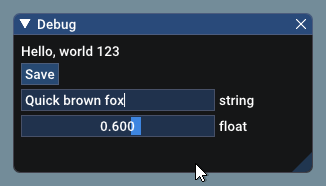
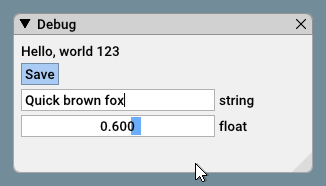
(settings: Dark style (left), Light style (right) / Font: Roboto-Medium, 16px)
Dear ImGui allows you to create elaborate tools as well as very short-lived ones. On the extreme side of short-livedness: using the Edit&Continue (hot code reload) feature of modern compilers you can add a few widgets to tweaks variables while your application is running, and remove the code a minute later! Dear ImGui is not just for tweaking values. You can use it to trace a running algorithm by just emitting text commands. You can use it along with your own reflection data to browse your dataset live. You can use it to expose the internals of a subsystem in your engine, to create a logger, an inspection tool, a profiler, a debugger, an entire game making editor/framework, etc.
Check out the Wiki’s About the IMGUI paradigm section if you want to understand the core principles behind the IMGUI paradigm. An IMGUI tries to minimize superfluous state duplication, state synchronization and state retention from the user’s point of view. It is less error prone (less code and less bugs) than traditional retained-mode interfaces, and lends itself to create dynamic user interfaces.
Dear ImGui outputs vertex buffers and command lists that you can easily render in your application. The number of draw calls and state changes required to render them is fairly small. Because Dear ImGui doesn’t know or touch graphics state directly, you can call its functions anywhere in your code (e.g. in the middle of a running algorithm, or in the middle of your own rendering process). Refer to the sample applications in the examples/ folder for instructions on how to integrate Dear ImGui with your existing codebase.
A common misunderstanding is to mistake immediate mode gui for immediate mode rendering, which usually implies hammering your driver/GPU with a bunch of inefficient draw calls and state changes as the gui functions are called. This is NOT what Dear ImGui does. Dear ImGui outputs vertex buffers and a small list of draw calls batches. It never touches your GPU directly. The draw call batches are decently optimal and you can render them later, in your app or even remotely.
See Releases page. Reading the changelogs is a good way to keep up to date with the things Dear ImGui has to offer, and maybe will give you ideas of some features that you’ve been ignoring until now!
You should be able to build the examples from sources (tested on Windows/Mac/Linux). If you don’t, let us know! If you want to have a quick look at some Dear ImGui features, you can download Windows binaries of the demo app here:
The demo applications are not DPI aware so expect some blurriness on a 4K screen. For DPI awareness in your application, you can load/reload your font at different scale, and scale your style with style.ScaleAllSizes() (see FAQ).
On most platforms and when using C++, you should be able to use a combination of the imgui_impl_xxxx backends without modification (e.g. imgui_impl_win32.cpp + imgui_impl_dx11.cpp ). If your engine supports multiple platforms, consider using more of the imgui_impl_xxxx files instead of rewriting them: this will be less work for you and you can get Dear ImGui running immediately. You can later decide to rewrite a custom backend using your custom engine functions if you wish so.
Integrating Dear ImGui within your custom engine is a matter of 1) wiring mouse/keyboard/gamepad inputs 2) uploading one texture to your GPU/render engine 3) providing a render function that can bind textures and render textured triangles. The examples/ folder is populated with applications doing just that. If you are an experienced programmer at ease with those concepts, it should take you less than two hours to integrate Dear ImGui in your custom engine. Make sure to spend time reading the FAQ, comments, and some of the examples/ application!
Officially maintained backends/bindings (in repository):
Also see Wiki for more links and ideas.
Some of the goals for 2021 are:
For more user-submitted screenshots of projects using Dear ImGui, check out the Gallery Threads!
For a list of third-party widgets and extensions, check out the Useful Extensions/Widgets wiki page.
Support, Frequently Asked Questions (FAQ)
See: Frequently Asked Questions (FAQ) where common questions are answered.
See: Wiki for many links, references, articles.
See: Articles about the IMGUI paradigm to read/learn about the Immediate Mode GUI paradigm.
Getting started? For first-time users having issues compiling/linking/running or issues loading fonts, please use GitHub Discussions.
For other questions, bug reports, requests, feedback, you may post on GitHub Issues. Please read and fill the New Issue template carefully.
Private support is available for paying business customers (E-mail: contact @ dearimgui dot com).
Which version should I get?
We occasionally tag Releases but it is generally safe and recommended to sync to master/latest. The library is fairly stable and regressions tend to be fixed fast when reported.
Advanced users may want to use the docking branch with Multi-Viewport and Docking features. This branch is kept in sync with master regularly.
Who uses Dear ImGui?
See the Quotes, Sponsors, Software using dear imgui Wiki pages for an idea of who is using Dear ImGui. Please add your game/software if you can! Also see the Gallery Threads!
How can I help?
How can I help financing further development of Dear ImGui?
Ongoing Dear ImGui development is currently financially supported by users and private sponsors:
Please see detailed list of Dear ImGui supporters for past sponsors. From November 2014 to December 2019, ongoing development has also been financially supported by its users on Patreon and through individual donations.
THANK YOU to all past and present supporters for helping to keep this project alive and thriving!
Dear ImGui is using software and services provided free of charge for open source projects:
Developed by Omar Cornut and every direct or indirect contributors to the GitHub. The early version of this library was developed with the support of Media Molecule and first used internally on the game Tearaway (PS Vita).
Recurring contributors (2020): Omar Cornut @ocornut, Rokas Kupstys @rokups, Ben Carter @ShironekoBen. A large portion of work on automation systems, regression tests and other features are currently unpublished.
Sponsoring, support contracts and other B2B transactions are hosted and handled by Lizardcube.
Omar: «I first discovered the IMGUI paradigm at Q-Games where Atman Binstock had dropped his own simple implementation in the codebase, which I spent quite some time improving and thinking about. It turned out that Atman was exposed to the concept directly by working with Casey. When I moved to Media Molecule I rewrote a new library trying to overcome the flaws and limitations of the first one I’ve worked with. It became this library and since then I have spent an unreasonable amount of time iterating and improving it.»
Embeds ProggyClean.ttf font by Tristan Grimmer (MIT license).
Inspiration, feedback, and testing for early versions: Casey Muratori, Atman Binstock, Mikko Mononen, Emmanuel Briney, Stefan Kamoda, Anton Mikhailov, Matt Willis. Also thank you to everyone posting feedback, questions and patches on GitHub.



